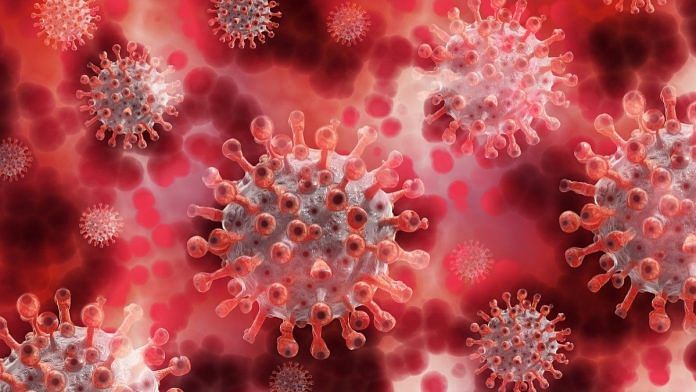New Delhi: The emergence of a new SARS-CoV-2 variant, Omicron EG.5.1 — nicknamed ‘Eris’ — has sparked fresh worries around the globe as the US and the UK report a surge in the number of fresh coronavirus infections resulting in hospitalisations. The World Health Organization (WHO) in July classified the mutant virus a ‘variant under monitoring’.
A scientist associated with India’s SARS-CoV-2 genomics consortium INSACOG confirmed that although the variant has been detected in India — in Bengaluru and Pune — no clusters have been found so far.
“We have kept a close eye on the genetic features of the emerging virus and its clinical manifestations but so far, there is no reason to worry,” said the official affiliated with the National Centre for Disease Control (NCDC), which leads INSACOG.
ThePrint explains the characteristics and symptoms of this new SARS-CoV-2 variant, and what the surge in infections means for India.
Also Read: ‘There was so much covered up’: NYT probe finds China ‘stifled’ research on Covid-19
How is Eris different from other variants?
Eris or Omicron EG.5.1 is a sub-strain of Omicron XBB — a highly transmissible variant — and has additional mutants on the spike proteins S: F456L and S: Q52H, which it uses to attach itself to the epithelial cells which line the human airway.
According to the INSACOG scientist quoted earlier, Eris has been found to be nearly 20-45 percent more transmissible than XBB.
On 2 August, the UK Health Security Agency (UKHSA) said EG.5.1 “was first raised (detected) as a signal in monitoring on 3 July 2023 as part of horizon scanning due to increasing reports internationally, particularly in Asia”.
The agency added that the variant “was subsequently raised from a signal in monitoring to a variant V-23JUL-01 (UK’s classification of the variant) on 31 July 2023 due to increasing number of genomes in UK data, and continued growth internationally”. It also said that declaring this lineage a variant will allow further detailed characterisation and analysis.
In the US, too, the Centers for Disease Control and Prevention (CDC) reported a steady rise in Covid-related hospitalisations in the month of July. There was a 12 percent increase in the number of hospitalisations in the week ending 22 July compared to the previous week.
What are the symptoms of the Eris variant?
The main symptoms of the new variant in circulation include sore throat, runny nose, blocked nose, sneezing, dry cough, headache and body pain, but most patients do not report fever or breathlessness, say doctors.
“The disease is not much different from what was seen with earlier Omicron and Covid strains and it is still a mild disease,” said Dr Sandeep Budhiraja, group medical director at Max Healthcare and senior director at its Institute of Internal Medicine.
He added that waning immunity from previous infections and vaccinations could be the reason behind the fresh spike in infections. “A bit of a concern is that an increase in the number of cases by Eris has been reported in other parts of the world, including in Europe and Asia, with even Japan reporting an increase in the number of cases,” he added.
However, Dr Budhiraja pointed out that although clinical symptoms associated with Eris may be based on early reports, the variant can have a growth advantage of almost 20 percent over previous strains, which means it can spread faster than earlier known Omicron strains.
He further emphasised the need to continue taking precautions. “That means wearing a mask if you have any symptoms of upper respiratory illness. You should keep yourself isolated, frequently wash your hands, and maintain social distance. If there are more people in a room, make sure that the room is properly ventilated,” he said.
Need to monitor variant?
Biologist Dr Anurag Agarwal, dean of the Trivedi School of Biosciences at Ashoka University, said the surge in cases of the new variant may be part of an expected cyclical phenomenon wherein variants with immune escape mutations emerge prior to a decline in immunity.
Immune escape mutations occur when the immune system of a host is no longer able to combat a pathogen.
“However, no surges of severe disease are expected since background immunity remains high,” he said, adding the caveat that “surveillance should be a continuous activity independent of ups and downs”.
Virologist Dr Gagandeep Kang, a professor at the department of gastrointestinal sciences at Christian Medical College, Vellore, pointed out that stable sentinel surveillance is a sensible approach to monitoring emerging SARS-CoV-2 variants since it will allow experts to assess whether there has been an increase in the proportion of new lineages over time.
Sentinel surveillance is a system that involves targeted monitoring of the occurrence of a specific disease with the help of a network of medical experts, laboratories and government agencies.
“A rapid increase in percentage positive of a new lineage means that it is spreading easily in the population,” she said.
Percentage positive or positivity rate is the percentage of all coronavirus tests performed that return positive.
Dr Kang added that this data “should be correlated with clinical information from cases; for example, what were the main symptoms? How severe was the illness? Do a large number (of those affected) need hospitalisation? Also virologists should provide input on whether the structural and genetic mutations predict escape from immunity.”
She told ThePrint that while Eris is a ‘variant under monitoring’, and not a ‘variant of concern’ yet, the best way forward is to track the data and see where it goes over the next few weeks.
(Edited by Amrtansh Arora)
Also Read: Webb telescope in homophobia row & Omicron study tests negative — 2022’s science controversies



